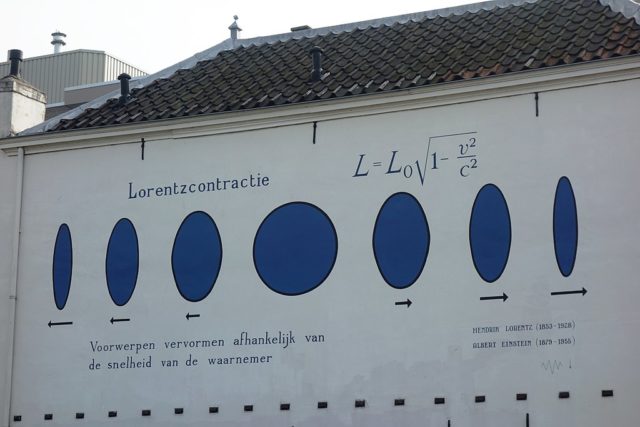The relativity of the length

After reading this article you can explain to your friends what this graffiti in Leiden (Netherlands) means, even if you have no idea of Dutch.
We are going to let Monica and Esteban rest and in this experiment Moisés will be the one that is in uniform movement in our platform wagon with respect to Esther, that remains static with respect to the ground. The experiment consists of something as simple as measuring the car.
Moses carries a meter to measure the length along his platform, that is, he will measure a length in the direction in which the object moves. He gets exactly 10 m. Esther tries to measure the length of the platform of Moses with his meter when the platform of Moses passes in front of his constant speed. It has to be fast, since it must read the two ends of the meter at the same moment; If this were not so, that is, if she measured one of the extremes first, the other would have moved forward before reaching it. As Ester is ingenious, she has designed an optical system that allows her to do it simultaneously. But there is a problem: the light from the front and from the back of the car takes a certain amount of time to reach it, and in that short period of time, the platform has advanced.
The lengths measured by the two observers are related to each other by the same square root that appeared for the dilation of time. Moses, who is at rest in relation to his platform, measures the length of the platform, but Esther, who must measure the length of Moses' moving platform from its stationary frame, measures its length as lm. Einstein showed that, due to the constant speed of light, these two lengths are not equal, but are related by the same square root that appeared for the dilation of time.
Indeed, since the speed of light c is constant, we can write that c = lm / Δtm = le / Δte where Δtm and Δte are the time intervals measured by each observer that it takes to travel the corresponding length. From here we have that lm = le · Δtm / Δte and as Δte = Δtm / √ (1-v2 / c2), we obtain that lm = le · √ (1-v2 / c2). [3]
This equation tells us that, since the speed of light is not infinite, Esther's measurement of the length of the platform always turns out to be shorter than the length measured by Moses, since the result of that square root is always smaller than 1. The faster the platform moves, the shorter it is for the measurement of Ester. If the platform is still, v = 0, and then lm = le.
Therefore:
Length measurements are not absolute and invariant, but relative. In fact, an object moving in relation to a stationary observer looks like that observer in that frame of reference that is shorter in the direction of movement than when its length is measured by an observer moving with the object; and it seems shorter the faster the object moves. This effect is known as length contraction.
But that does not mean that the object contracts when it moves: the "contraction" observed, which is only in the direction of movement, not perpendicular to it, is an effect of the measurement made from another system, as was the effect on the relative observations of elapsed time, the "dilation" of time.
When v = 0.8c, for example, the apparent shortening seen by Esther of the platform of Moses moving to the right, and of Moses himself and everything that moves with him, would be about 0.6 le. But, remember, there are no special frames of reference [4], so it is symmetric. As Moses can consider that his frame of reference is at rest, Esther seems to move quickly to the left, and it is she and everything that accompanies her that seems to Moses shortened by the same amount.
The apparent contraction continues until the speed of light, at which point the length of the moving object will appear as zero to the stationary observer. However, you can not get any mass to reach the speed of light, so you can never reach the zero length, although in the accelerators (colliders) the elementary particles are close enough to that limit.
Notes:
[1] Popularly, theory of relativity.
[2] I beg the indulgence of the attentive reader for reiterating the obvious; we do it thinking of other readers, perhaps not so attentive.
[3] There will be someone who looks like a lot of mathematics, but we are talking about elementary algebra, raising power and finding square roots. And the wonderful thing is that they are all the mathematics that are needed to understand one of the most fantastic theories created by the human mind. And they are given in elementary school!
[4] According to the principle of relativity, there is no experiment that can be performed within an inertial frame of reference that reveals whether it is at rest or moving at a uniform speed. An inertial frame of reference is a frame of reference which is at rest or in uniform velocity in relation to another frame of reference.
About the author: César Tomé López is a scientific disseminator and editor of Mapping Ignorance